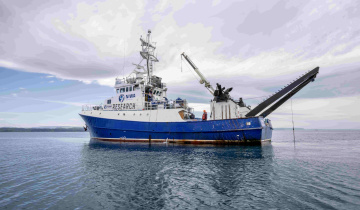This programme runs until 2013. To date, we've achieved many key milestones towards developing elite kingfish, hāpuku, and pāua broodstock for the future aquaculture industry. These are summarised below.
Breeding
- Collected new wild broodstock and spawned all three species in captivity.
- Spawned F1 (first domesticated generation) kingfish in captivity, producing good quality eggs and F2 larvae during two spawning seasons. This removes the future reliance on wild-caught broodstock.
- Established 100 family lines for pāua, 43 for hāpuku, and more than 20 for kingfish.
- Achieved controlled matings for kingfish and established that matings can be manipulated without interrupting spawning or compromising egg production and fertilisation. This will enable more crosses to be achieved, producing more families and greater genetic diversity among the captive population.
- Developed accurate methods for sexing broodstock. Using ultrasound to visualise gonads and determine the sex of live hāpuku has proven to be reliable prior to spawning when the gonads are well developed.
- Developed computer models to help design the most appropriate breeding programme for each species, in conjunction with AbacusBio Ltd.
Genetics
- With AgResearch Ltd, developed microsatellite DNA markers to establish parentage in all three species.
- Used egg genotyping to establish parental contribution during communal spawning in kingfish and hāpuku. This has confirmed that communal spawning can result in offspring from a limited number of parents.
- Established heritability for growth traits in hāpuku – a world first. Heritability was high, indicating that there is significant genetic variability for growth in farmed hāpuku.
- Identified moderate-to-high heritability for growth traits in pāua.
What have DNA markers told us so far?
- More hāpuku and kingfish spawn in the middle of the spawning season, making this the best time to collect eggs for incubation to generate multiple families.
- Size does matter for wild kingfish: so far we have found that smaller males tend to contribute more during spawning.
- For pāua, the markers have been used to test how early rearing environment influences family performance and contribution.
Nutrition
- Broodstock nutrition trials are underway and new diets have been successfully manufactured with different proportions of omega-3 fatty acids.
- Results show these diets are readily consumed by the broodstock which then grow to sexual maturity and spawn.






